
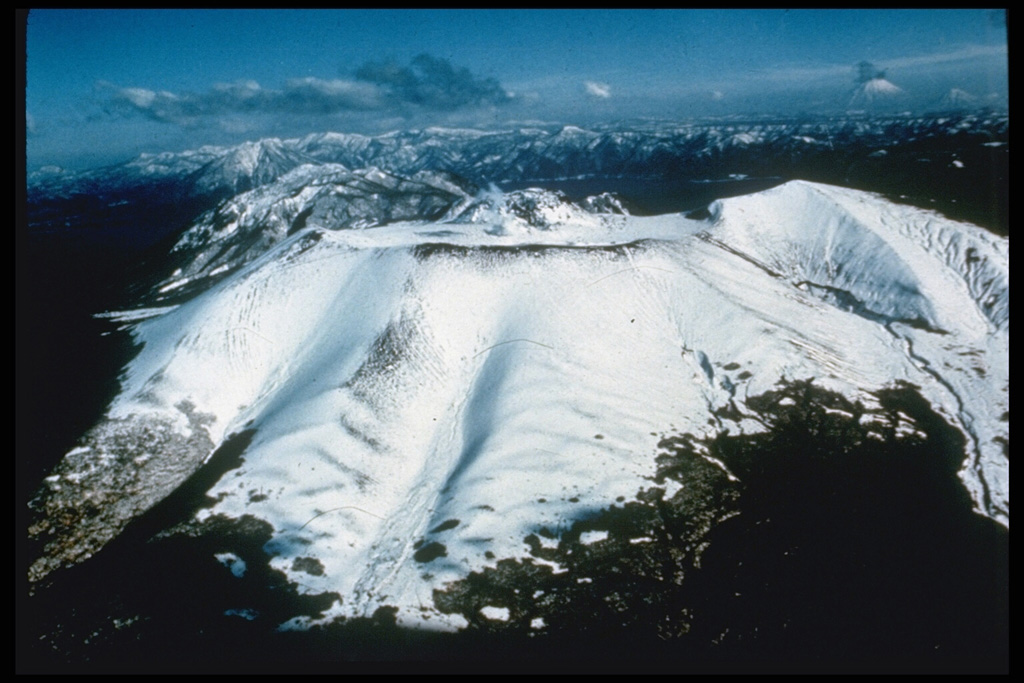
Tarumai stratovolcano on the caldera's rim is site of 65 earthquakes
The number of volcanic earthquakes beneath Tarumai stratovolcano increased during the second half of August. A total of 65 earthquakes was recorded in August.
Information Contacts: Volcanological Division, Japan Meteorological Agency (JMA), 1-3-4 Ote-machi, Chiyoda-ku, Tokyo 100, Japan.
The Global Volcanism Program has no Weekly Reports available for Shikotsu.
Reports are organized chronologically and indexed below by Month/Year (Publication Volume:Number), and include a one-line summary. Click on the index link or scroll down to read the reports.
Explosive eruption with small pyroclastic flow after 10 years of increasing seismicity
Tarumai exploded on 14 May at 2253, accompanied by volcanic tremor. A slight ashfall was observed 10 km NNE of the summit crater and a small pyroclastic flow consisting of pumiceous ash and blocks traveled 150 m SE from the vent. Sixteen hours after the eruption, geologists measured a temperature of 200°C at the base of the pyroclastic flow (30 cm below the surface). Smaller explosions occurred on 17 May, mantling the vent area with 1 cm of new ash. No further explosions had been observed as of 7 June.
Tarumai, which last erupted in 1955, is characterized by conspicuous earthquake swarms, followed by explosive eruptions of andesitic magma, then lava dome extrusion. The number of earthquakes at Tarumai has been increasing irregularly for the past 10 years and increased sharply in the first five months of 1978 (figure 1). No eruption was associated with the somewhat smaller peak in seismicity that occurred in 1975.
 |
Figure 1. Monthly seismicity recorded at JMA's Tarumai Observatory, January 1978-June 1979. Arrows represent ash eruptions. Courtesy of JMA. |
Further Reference. Katsui, Y., Onuma, K., Niida, K., Suzuki, T., and Kondo, Y., 1979, Eruption of Tarumai volcano in May 1978: Bulletin of the Volcanological Society of Japan, v. 24, no. 2, p. 31-40.
Information Contacts: JMA, Tokyo; D. Shackelford, CA.
No new explosions; seismicity declines to normal
As of early July, no eruptive activity had been observed since the explosions of 14 and 17 May. Seismicity decreased to its normal level in mid-June after a 10-year increase preceding the May explosions.
Information Contacts: JMA, Tokyo.
Two small ash eruptions
Tarumai erupted ash from 0910 to 0920 on 12 December. The ash cloud rose 200 m above the vent, which was also the source of small explosions on 14 and 17 May. Ash slightly darkened the snow in the summit area, but did not reach the foot of the volcano. A second ash eruption occurred on 16 December, with ashfall again restricted to the summit area. Seismicity remained at a low level (table 1).
Table 1. Monthly seismicity at Shikotsu (Tarumai) in 1978. Courtesy of JMA.
| Month | Seismic Events |
| Jan 1978 | 22 |
| Feb 1978 | 39 |
| Mar 1978 | 95 |
| Apr 1978 | 170 |
| May 1978 | 298 |
| Jun 1978 | 112 |
| Jul 1978 | 26 |
| Aug 1978 | 18 |
| Sep 1978 | 13 |
| Oct 1978 | 17 |
| Nov 1978 | 13 |
| Dec 1978 | [21] |
Information Contacts: JMA, Tokyo.
Ash eruptions continue
Ash eruptions continued through early January. Ash was ejected on 16, 26, and 29 December and on 5 January, falling on the summit area. Seismicity remained at normal levels through December.
Information Contacts: JMA, Tokyo.
Small ash eruptions continue; seismicity increases sharply
Ash eruptions continued through January. Ash was ejected on 5, 22, 23, and 27 January, darkening snow in the summit area, but no ash reached the foot of the volcano.
Local seismicity increased sharply about 10 January, after several months of relative quiet. An irregular increase in seismic activity has persisted since 1967.
Information Contacts: JMA, Tokyo.
Small ash eruptions and increased seismicity continue
Ash was ejected on 5, 8, 19, and 25-28 February, continuing the series of small explosions that resumed 12 December. The ash darkened snow in the summit area, but did not reach the foot of the volcano. The number of recorded local earthquakes increased from 201 in January to 427 in February.
Information Contacts: JMA, Tokyo.
More ash eruptions but declining seismicity
Ash eruptions continued in March. Ash fell on the summit area on 1, 2, 4, 6, and 8 March but did not reach the foot of the volcano. Seismicity declined considerably in March, but remained slightly above the monthly total for January.
Information Contacts: JMA, Tokyo.
Seismicity and number of explosions decline
Eruptive and seismic activity declined substantially in April. Only one [ash eruption] took place in April, on the 13th, causing a small ashfall in the summit area. The monthly number of recorded earthquakes dropped from 223 in March to 70 in April.
Information Contacts: JMA, Tokyo.
Small ash eruption but decline in seismicity persists
The decline in activity continued through May. A single small ash eruption occurred in May, on the 11th. Ash fell in the summit area but not reach the foot of the volcano. Monthly recorded earthquakes decreased slightly from 70 in April to 66 in May, but the number of tremor events dropped more sharply, from more than 40 to 9. The tremor events, each lasting a few minutes, were thought to be generated by vigorous activity at a vent. The strongest of this activity was visible from the base of the volcano.
Information Contacts: JMA, Tokyo.
Seismicity increases, but no explosions
No explosions or tremor events were recorded in June. However, the number of local earthquakes, which had been declining since March, increased in June.
Information Contacts: JMA, Tokyo.
No explosions; seismicity declines
The number of recorded earthquakes declined to 58 in July after rising sharply to 142 in June. No explosions were observed in July, nor were any tremor events, which are presumably generated by [ash ejection].
Information Contacts: JMA, Tokyo.
Brief increase in seismicity, but no eruption
An increase in the number of local earthquakes and a resumption of tremor events occurred in mid-September, but no eruption was observed. In October, seismicity returned to normal levels and no tremor events were recorded.
Information Contacts: JMA, Tokyo.
Seismicity increases
Seismic activity increased in November after about one and a half years of quiet.
Information Contacts: JMA, Tokyo.
Seismicity continues to increase
Seismic activity increased again to more than 400 recorded events during January. No eruption has yet been observed. About 200 events per month were recorded in November and December, after over a year of fewer than 50 events per month.
Information Contacts: JMA, Tokyo.
Sharp increase in seismicity
In February, 1,121 seismic events were recorded, the most in any month since 1967, when JMA began routine measurements at the volcano. Seismicity has irregularly but gradually increased in the past 14 years (figure 2). No eruption has occurred during the current increase in seismicity.
Information Contacts: JMA, Tokyo.
Seismicity declines without expected eruption
Local seismicity began to increase in November 1980 and the number of events per month reached 1,211 in February 1981 (figure 3). Seismicity began a gradual decline in early March and by mid-March had reached the usual average of fewer than three recorded earthquakes per day.
 |
Figure 3. Monthly numbers of days with eruptions (top), tremor events (center), and recorded earthquakes (bottom) at Tarumai, January 1978-March 1981. Courtesy of JMA. |
Only 87 events were recorded in March. Although the December 1978-May 1979 eruption accompanied the last major increase in seismicity, no eruption has occurred during the current, much larger increase [but see 06:04].
Information Contacts: JMA, Tokyo.
Minor ash emission during February seismic peak
Seismicity declined to its usual level of fewer than three recorded earthquakes per day in March and remained at this level through April. Although no volcanic activity apparently had accompanied the peak of seismicity in February (1,211 events), subsequent investigation revealed that a weak steam explosion had occurred on 27 February or a few days earlier.
On the morning of 27 February an All Nippon Airways crew reported that they saw radially darkened snow on the SE part of the summit area. Yoshio Katsui visited the summit on 9 April and found a single layer of gray ash in the snow. The ash layer was only 0.3-0.6 mm thick at the crater rim. The total volume of ejecta was estimated to be no more than 400 m3.
Information Contacts: JMA, Tokyo; Y. Katsui, Hokkaido Univ.
Earthquake swarms
Local earthquake swarms occurred 24 January-18 February. The JMA seismometer, 1.1 km NE of the summit cone, recorded 30 events in January and 124 in February. Epicenters were located at the NW somma using data from five Hokkaido University seismometers. A white plume constantly rose ~100 m.
Tarumai's strongest earthquake swarm of the past two decades began in late 1980, peaking in February 1981, when more than 1,200 shocks were recorded. Late that month ~400 m3 of ash was deposited near the crater by a very small eruption. Seismicity then declined, and the number of local events has averaged <10/month in the last few years (figure 4).
Information Contacts: JMA.
Seismic activity increases
The number of volcanic earthquakes beneath Tarumai stratovolcano (on the rim on Shikotsu caldera) increased in June and July. There were 13 events on both 8 and 10 June. A total of 64 earthquakes was recorded in July.
Information Contacts: Volcanological Division, Japan Meteorological Agency, 1-3-4 Ote-machi, Chiyoda-ku, Tokyo 100, Japan
Tarumai stratovolcano on the caldera's rim is site of 65 earthquakes
The number of volcanic earthquakes beneath Tarumai stratovolcano increased during the second half of August. A total of 65 earthquakes was recorded in August.
Information Contacts: Volcanological Division, Japan Meteorological Agency (JMA), 1-3-4 Ote-machi, Chiyoda-ku, Tokyo 100, Japan.
|
|
||||||||||||||||||||||||||
There is data available for 41 confirmed Holocene eruptive periods.
1981 Feb 27 - 1981 Feb 27 Confirmed Eruption (Phreatic) VEI: 1
| Episode 1 | Eruption (Phreatic) | Tarumai | ||||||||||||||||||||||||
|---|---|---|---|---|---|---|---|---|---|---|---|---|---|---|---|---|---|---|---|---|---|---|---|---|---|
| 1981 Feb 27 - 1981 Feb 27 | Evidence from Observations: Reported | ||||||||||||||||||||||||
|
List of 3 Events for Episode 1 at Tarumai
|
|||||||||||||||||||||||||
1978 Dec 12 - 1979 May 11 Confirmed Eruption (Explosive / Effusive) VEI: 1
| Episode 1 | Eruption (Explosive / Effusive) | Tarumai (SE foot of summit dome) | ||||||||||||||||||||||||||||||||||||||||||||
|---|---|---|---|---|---|---|---|---|---|---|---|---|---|---|---|---|---|---|---|---|---|---|---|---|---|---|---|---|---|---|---|---|---|---|---|---|---|---|---|---|---|---|---|---|---|
| 1978 Dec 12 - 1979 May 11 | Evidence from Observations: Reported | ||||||||||||||||||||||||||||||||||||||||||||
|
List of 7 Events for Episode 1 at Tarumai (SE foot of summit dome)
|
|||||||||||||||||||||||||||||||||||||||||||||
1978 May 14 - 1978 May 17 Confirmed Eruption (Explosive / Effusive) VEI: 1
| Episode 1 | Eruption (Explosive / Effusive) | Tarumai (SE foot of summit dome) | |||||||||||||||||||||||||||||||||||||||
|---|---|---|---|---|---|---|---|---|---|---|---|---|---|---|---|---|---|---|---|---|---|---|---|---|---|---|---|---|---|---|---|---|---|---|---|---|---|---|---|---|
| 1978 May 14 - 1978 May 17 | Evidence from Observations: Reported | |||||||||||||||||||||||||||||||||||||||
|
List of 6 Events for Episode 1 at Tarumai (SE foot of summit dome)
|
||||||||||||||||||||||||||||||||||||||||
1954 Nov 19 - 1955 Feb 14 Confirmed Eruption (Explosive / Effusive) VEI: 1
| Episode 1 | Eruption (Explosive / Effusive) | Tarumai | |||||||||||||||||||||||||||||
|---|---|---|---|---|---|---|---|---|---|---|---|---|---|---|---|---|---|---|---|---|---|---|---|---|---|---|---|---|---|---|
| 1954 Nov 19 - 1955 Feb 14 | Evidence from Observations: Reported | |||||||||||||||||||||||||||||
|
List of 4 Events for Episode 1 at Tarumai
|
||||||||||||||||||||||||||||||
1954 May 2 - 1954 May 2 Confirmed Eruption (Explosive / Effusive) VEI: 1
| Episode 1 | Eruption (Explosive / Effusive) | Tarumai | |||||||||||||||||||||||||||||
|---|---|---|---|---|---|---|---|---|---|---|---|---|---|---|---|---|---|---|---|---|---|---|---|---|---|---|---|---|---|---|
| 1954 May 2 - 1954 May 2 | Evidence from Observations: Reported | |||||||||||||||||||||||||||||
|
List of 4 Events for Episode 1 at Tarumai
|
||||||||||||||||||||||||||||||
1953 Sep 14 (?) - 1953 Sep 14 (?) Confirmed Eruption (Explosive / Effusive) VEI: 1
| Episode 1 | Eruption (Explosive / Effusive) | Tarumai | ||||||||||||||||||||||||
|---|---|---|---|---|---|---|---|---|---|---|---|---|---|---|---|---|---|---|---|---|---|---|---|---|---|
| 1953 Sep 14 (?) - 1953 Sep 14 (?) | Evidence from Observations: Reported | ||||||||||||||||||||||||
|
List of 3 Events for Episode 1 at Tarumai
|
|||||||||||||||||||||||||
1951 Jul 28 - 1951 Jul 28 Confirmed Eruption (Explosive / Effusive) VEI: 2
| Episode 1 | Eruption (Explosive / Effusive) | Tarumai | ||||||||||||||||||||||||||||||||||
|---|---|---|---|---|---|---|---|---|---|---|---|---|---|---|---|---|---|---|---|---|---|---|---|---|---|---|---|---|---|---|---|---|---|---|---|
| 1951 Jul 28 - 1951 Jul 28 | Evidence from Observations: Reported | ||||||||||||||||||||||||||||||||||
|
List of 5 Events for Episode 1 at Tarumai
|
|||||||||||||||||||||||||||||||||||
1951 Jan 29 - 1951 Jan 29 Confirmed Eruption (Explosive / Effusive) VEI: 2
| Episode 1 | Eruption (Explosive / Effusive) | Tarumai | ||||||||||||||||||||||||||||||||||
|---|---|---|---|---|---|---|---|---|---|---|---|---|---|---|---|---|---|---|---|---|---|---|---|---|---|---|---|---|---|---|---|---|---|---|---|
| 1951 Jan 29 - 1951 Jan 29 | Evidence from Observations: Reported | ||||||||||||||||||||||||||||||||||
|
List of 5 Events for Episode 1 at Tarumai
|
|||||||||||||||||||||||||||||||||||
[ 1947 Oct 15 ± 90 days - 1947 Oct 15 ± 90 days ] Uncertain Eruption
| Episode 1 | Eruption (Explosive / Effusive) | Tarumai | |||||||||||||||||||
|---|---|---|---|---|---|---|---|---|---|---|---|---|---|---|---|---|---|---|---|---|
| 1947 Oct 15 ± 90 days - 1947 Oct 15 ± 90 days | Evidence from Observations: Reported | |||||||||||||||||||
|
List of 2 Events for Episode 1 at Tarumai
|
||||||||||||||||||||
1944 Jul 2 - 1944 Jul 2 Confirmed Eruption (Explosive / Effusive) VEI: 1
| Episode 1 | Eruption (Explosive / Effusive) | Tarumai | ||||||||||||||||||||||||
|---|---|---|---|---|---|---|---|---|---|---|---|---|---|---|---|---|---|---|---|---|---|---|---|---|---|
| 1944 Jul 2 - 1944 Jul 2 | Evidence from Observations: Reported | ||||||||||||||||||||||||
|
List of 3 Events for Episode 1 at Tarumai
|
|||||||||||||||||||||||||
1936 Nov 15 - 1936 Nov 26 Confirmed Eruption (Explosive / Effusive) VEI: 1
| Episode 1 | Eruption (Explosive / Effusive) | Tarumai | |||||||||||||||||||||||||||||
|---|---|---|---|---|---|---|---|---|---|---|---|---|---|---|---|---|---|---|---|---|---|---|---|---|---|---|---|---|---|---|
| 1936 Nov 15 - 1936 Nov 26 | Evidence from Observations: Reported | |||||||||||||||||||||||||||||
|
List of 4 Events for Episode 1 at Tarumai
|
||||||||||||||||||||||||||||||
1936 Apr 19 - 1936 Apr 19 Confirmed Eruption (Explosive / Effusive) VEI: 1
| Episode 1 | Eruption (Explosive / Effusive) | Tarumai | |||||||||||||||||||
|---|---|---|---|---|---|---|---|---|---|---|---|---|---|---|---|---|---|---|---|---|
| 1936 Apr 19 - 1936 Apr 19 | Evidence from Observations: Reported | |||||||||||||||||||
|
List of 2 Events for Episode 1 at Tarumai
|
||||||||||||||||||||
1933 Dec 1 - 1933 Dec 14 Confirmed Eruption (Explosive / Effusive) VEI: 2
| Episode 1 | Eruption (Explosive / Effusive) | Tarumai (east-west summit fissure) | ||||||||||||||||||||||||||||||||||
|---|---|---|---|---|---|---|---|---|---|---|---|---|---|---|---|---|---|---|---|---|---|---|---|---|---|---|---|---|---|---|---|---|---|---|---|
| 1933 Dec 1 - 1933 Dec 14 | Evidence from Observations: Reported | ||||||||||||||||||||||||||||||||||
|
List of 5 Events for Episode 1 at Tarumai (east-west summit fissure)
|
|||||||||||||||||||||||||||||||||||
1931 Oct 11 - 1931 Oct 24 Confirmed Eruption (Explosive / Effusive) VEI: 1
| Episode 1 | Eruption (Explosive / Effusive) | Tarumai | |||||||||||||||||||
|---|---|---|---|---|---|---|---|---|---|---|---|---|---|---|---|---|---|---|---|---|
| 1931 Oct 11 - 1931 Oct 24 | Evidence from Observations: Reported | |||||||||||||||||||
|
List of 2 Events for Episode 1 at Tarumai
|
||||||||||||||||||||
1928 Sep 6 - 1929 Feb 10 Confirmed Eruption (Explosive / Effusive) VEI: 1
| Episode 1 | Eruption (Explosive / Effusive) | Tarumai | |||||||||||||||||||
|---|---|---|---|---|---|---|---|---|---|---|---|---|---|---|---|---|---|---|---|---|
| 1928 Sep 6 - 1929 Feb 10 | Evidence from Observations: Reported | |||||||||||||||||||
|
List of 2 Events for Episode 1 at Tarumai
|
||||||||||||||||||||
1928 Jan 7 - 1928 Jan 7 Confirmed Eruption (Explosive / Effusive) VEI: 2
| Episode 1 | Eruption (Explosive / Effusive) | Tarumai | |||||||||||||||||||||||||||||
|---|---|---|---|---|---|---|---|---|---|---|---|---|---|---|---|---|---|---|---|---|---|---|---|---|---|---|---|---|---|---|
| 1928 Jan 7 - 1928 Jan 7 | Evidence from Observations: Reported | |||||||||||||||||||||||||||||
|
List of 4 Events for Episode 1 at Tarumai
|
||||||||||||||||||||||||||||||
1926 Oct 19 - 1926 Oct 30 Confirmed Eruption (Explosive / Effusive) VEI: 2
| Episode 1 | Eruption (Explosive / Effusive) | Tarumai | ||||||||||||||||||||||||||||||||||
|---|---|---|---|---|---|---|---|---|---|---|---|---|---|---|---|---|---|---|---|---|---|---|---|---|---|---|---|---|---|---|---|---|---|---|---|
| 1926 Oct 19 - 1926 Oct 30 | Evidence from Observations: Reported | ||||||||||||||||||||||||||||||||||
|
List of 5 Events for Episode 1 at Tarumai
|
|||||||||||||||||||||||||||||||||||
1923 Feb - 1923 Aug 23 Confirmed Eruption (Explosive / Effusive) VEI: 1
| Episode 1 | Eruption (Explosive / Effusive) | Tarumai | |||||||||||||||||||||||||||||
|---|---|---|---|---|---|---|---|---|---|---|---|---|---|---|---|---|---|---|---|---|---|---|---|---|---|---|---|---|---|---|
| 1923 Feb - 1923 Aug 23 | Evidence from Observations: Reported | |||||||||||||||||||||||||||||
|
List of 4 Events for Episode 1 at Tarumai
|
||||||||||||||||||||||||||||||
1921 Jul 6 - 1921 Jul 6 Confirmed Eruption (Explosive / Effusive) VEI: 1
| Episode 1 | Eruption (Explosive / Effusive) | Tarumai | |||||||||||||||||||||||||||||
|---|---|---|---|---|---|---|---|---|---|---|---|---|---|---|---|---|---|---|---|---|---|---|---|---|---|---|---|---|---|---|
| 1921 Jul 6 - 1921 Jul 6 | Evidence from Observations: Reported | |||||||||||||||||||||||||||||
|
List of 4 Events for Episode 1 at Tarumai
|
||||||||||||||||||||||||||||||
1920 Jul 17 - 1920 Jul 23 Confirmed Eruption (Explosive / Effusive) VEI: 1
| Episode 1 | Eruption (Explosive / Effusive) | Tarumai | |||||||||||||||||||||||||||||
|---|---|---|---|---|---|---|---|---|---|---|---|---|---|---|---|---|---|---|---|---|---|---|---|---|---|---|---|---|---|---|
| 1920 Jul 17 - 1920 Jul 23 | Evidence from Observations: Reported | |||||||||||||||||||||||||||||
|
List of 4 Events for Episode 1 at Tarumai
|
||||||||||||||||||||||||||||||
1919 May 4 - 1919 May 4 Confirmed Eruption (Explosive / Effusive) VEI: 2
| Episode 1 | Eruption (Explosive / Effusive) | Tarumai | |||||||||||||||||||||||||||||
|---|---|---|---|---|---|---|---|---|---|---|---|---|---|---|---|---|---|---|---|---|---|---|---|---|---|---|---|---|---|---|
| 1919 May 4 - 1919 May 4 | Evidence from Observations: Reported | |||||||||||||||||||||||||||||
|
List of 4 Events for Episode 1 at Tarumai
|
||||||||||||||||||||||||||||||
1918 Jun 13 - 1918 Jul 31 Confirmed Eruption (Explosive / Effusive) VEI: 1
| Episode 1 | Eruption (Explosive / Effusive) | Tarumai | |||||||||||||||||||||||||||||
|---|---|---|---|---|---|---|---|---|---|---|---|---|---|---|---|---|---|---|---|---|---|---|---|---|---|---|---|---|---|---|
| 1918 Jun 13 - 1918 Jul 31 | Evidence from Observations: Reported | |||||||||||||||||||||||||||||
|
List of 4 Events for Episode 1 at Tarumai
|
||||||||||||||||||||||||||||||
1917 Apr 30 - 1917 May 12 Confirmed Eruption (Explosive / Effusive) VEI: 2
| Episode 1 | Eruption (Explosive / Effusive) | Tarumai (east-west summit fissure) | |||||||||||||||||||||||||||||
|---|---|---|---|---|---|---|---|---|---|---|---|---|---|---|---|---|---|---|---|---|---|---|---|---|---|---|---|---|---|---|
| 1917 Apr 30 - 1917 May 12 | Evidence from Observations: Reported | |||||||||||||||||||||||||||||
|
List of 4 Events for Episode 1 at Tarumai (east-west summit fissure)
|
||||||||||||||||||||||||||||||
1909 Jan 11 - 1909 Apr 22 Confirmed Eruption (Explosive / Effusive) VEI: 3
| Episode 1 | Eruption (Explosive / Effusive) | Tarumai | ||||||||||||||||||||||||||||||||||||||||||||||||||||||||||||||||
|---|---|---|---|---|---|---|---|---|---|---|---|---|---|---|---|---|---|---|---|---|---|---|---|---|---|---|---|---|---|---|---|---|---|---|---|---|---|---|---|---|---|---|---|---|---|---|---|---|---|---|---|---|---|---|---|---|---|---|---|---|---|---|---|---|---|
| 1909 Jan 11 - 1909 Apr 22 | Evidence from Observations: Reported | ||||||||||||||||||||||||||||||||||||||||||||||||||||||||||||||||
|
List of 11 Events for Episode 1 at Tarumai
|
|||||||||||||||||||||||||||||||||||||||||||||||||||||||||||||||||
1894 Aug 17 - 1894 Aug 17 Confirmed Eruption (Explosive / Effusive) VEI: 2
| Episode 1 | Eruption (Explosive / Effusive) | Tarumai | ||||||||||||||||||||||||
|---|---|---|---|---|---|---|---|---|---|---|---|---|---|---|---|---|---|---|---|---|---|---|---|---|---|
| 1894 Aug 17 - 1894 Aug 17 | Evidence from Observations: Reported | ||||||||||||||||||||||||
|
List of 3 Events for Episode 1 at Tarumai
|
|||||||||||||||||||||||||
1894 Feb 8 - 1894 Feb 8 Confirmed Eruption (Explosive / Effusive) VEI: 2
| Episode 1 | Eruption (Explosive / Effusive) | Tarumai | |||||||||||||||||||||||||||||
|---|---|---|---|---|---|---|---|---|---|---|---|---|---|---|---|---|---|---|---|---|---|---|---|---|---|---|---|---|---|---|
| 1894 Feb 8 - 1894 Feb 8 | Evidence from Observations: Reported | |||||||||||||||||||||||||||||
|
List of 4 Events for Episode 1 at Tarumai
|
||||||||||||||||||||||||||||||
1887 Sep 3 - 1887 Oct 8 Confirmed Eruption (Explosive / Effusive) VEI: 2
| Episode 1 | Eruption (Explosive / Effusive) | Tarumai | ||||||||||||||||||||||||
|---|---|---|---|---|---|---|---|---|---|---|---|---|---|---|---|---|---|---|---|---|---|---|---|---|---|
| 1887 Sep 3 - 1887 Oct 8 | Evidence from Observations: Reported | ||||||||||||||||||||||||
|
List of 3 Events for Episode 1 at Tarumai
|
|||||||||||||||||||||||||
1886 Apr 13 - 1886 Apr 28 Confirmed Eruption (Explosive / Effusive) VEI: 2
| Episode 1 | Eruption (Explosive / Effusive) | Tarumai | ||||||||||||||||||||||||
|---|---|---|---|---|---|---|---|---|---|---|---|---|---|---|---|---|---|---|---|---|---|---|---|---|---|
| 1886 Apr 13 - 1886 Apr 28 | Evidence from Observations: Reported | ||||||||||||||||||||||||
|
List of 3 Events for Episode 1 at Tarumai
|
|||||||||||||||||||||||||
1885 Jan 4 - 1885 Mar 26 Confirmed Eruption (Explosive / Effusive) VEI: 2
JMA (2013) described a phreatic summit eruption with ashfall on 4 January 1885, followed by small eruptions on 8 and 10 January. Another summit eruption on 26 March had a volcanic plume "slightly less" than the January activity.
| Episode 1 | Eruption (Explosive / Effusive) | Tarumai | ||||||||||||||||||||||||||||||||||
|---|---|---|---|---|---|---|---|---|---|---|---|---|---|---|---|---|---|---|---|---|---|---|---|---|---|---|---|---|---|---|---|---|---|---|---|
| 1885 Jan 4 - 1885 Jan 10 | Evidence from Observations: Reported | ||||||||||||||||||||||||||||||||||
|
List of 5 Events for Episode 1 at Tarumai
|
|||||||||||||||||||||||||||||||||||
| Episode 2 | Eruption (Explosive / Effusive) | Tarumai | |||||||||||||||||||
|---|---|---|---|---|---|---|---|---|---|---|---|---|---|---|---|---|---|---|---|---|
| 1885 Mar 26 - 1885 Mar 26 | Evidence from Observations: Reported | |||||||||||||||||||
|
List of 2 Events for Episode 2 at Tarumai
|
||||||||||||||||||||
1883 Oct 7 - 1883 Nov 5 Confirmed Eruption (Explosive / Effusive) VEI: 2
| Episode 1 | Eruption (Explosive / Effusive) | Tarumai | ||||||||||||||||||||||||
|---|---|---|---|---|---|---|---|---|---|---|---|---|---|---|---|---|---|---|---|---|---|---|---|---|---|
| 1883 Oct 7 - 1883 Nov 5 | Evidence from Observations: Reported | ||||||||||||||||||||||||
|
List of 3 Events for Episode 1 at Tarumai
|
|||||||||||||||||||||||||
1874 Feb 8 - 1874 Feb 16 Confirmed Eruption (Explosive / Effusive) VEI: 3
| Episode 1 | Eruption (Explosive / Effusive) | Tarumai | ||||||||||||||||||||||||||||||||||||||||||||
|---|---|---|---|---|---|---|---|---|---|---|---|---|---|---|---|---|---|---|---|---|---|---|---|---|---|---|---|---|---|---|---|---|---|---|---|---|---|---|---|---|---|---|---|---|---|
| 1874 Feb 8 - 1874 Feb 16 | Evidence from Observations: Reported | ||||||||||||||||||||||||||||||||||||||||||||
|
List of 7 Events for Episode 1 at Tarumai
|
|||||||||||||||||||||||||||||||||||||||||||||
[ 1871 Dec 25 - 1871 Dec 28 ] Uncertain Eruption
| Episode 1 | Eruption (Explosive / Effusive) | Tarumai | ||||||||||||||||||||||||
|---|---|---|---|---|---|---|---|---|---|---|---|---|---|---|---|---|---|---|---|---|---|---|---|---|---|
| 1871 Dec 25 - 1871 Dec 28 | Evidence from Unknown | ||||||||||||||||||||||||
|
List of 3 Events for Episode 1 at Tarumai
|
|||||||||||||||||||||||||
1867 Sep 8 Confirmed Eruption (Explosive / Effusive) VEI: 2
| Episode 1 | Eruption (Explosive / Effusive) | Tarumai | |||||||||||||||||||||||||||||
|---|---|---|---|---|---|---|---|---|---|---|---|---|---|---|---|---|---|---|---|---|---|---|---|---|---|---|---|---|---|---|
| 1867 Sep 8 - Unknown | Evidence from Observations: Reported | |||||||||||||||||||||||||||||
|
List of 4 Events for Episode 1 at Tarumai
|
||||||||||||||||||||||||||||||
1804 - 1817 Confirmed Eruption (Explosive / Effusive) VEI: 3
| Episode 1 | Eruption (Explosive / Effusive) | Tarumai | |||||||||||||||||||||||||||||||||||||||||||||||||
|---|---|---|---|---|---|---|---|---|---|---|---|---|---|---|---|---|---|---|---|---|---|---|---|---|---|---|---|---|---|---|---|---|---|---|---|---|---|---|---|---|---|---|---|---|---|---|---|---|---|---|
| 1804 - 1817 | Evidence from Observations: Reported | |||||||||||||||||||||||||||||||||||||||||||||||||
|
List of 8 Events for Episode 1 at Tarumai
|
||||||||||||||||||||||||||||||||||||||||||||||||||
1739 Aug 19 - 1739 Aug 31 Confirmed Eruption (Explosive / Effusive) VEI: 5
| Episode 1 | Eruption (Explosive / Effusive) | Tarumai, Ta-a tephra | |||||||||||||||||||||||||||||||||||||||||||||||||
|---|---|---|---|---|---|---|---|---|---|---|---|---|---|---|---|---|---|---|---|---|---|---|---|---|---|---|---|---|---|---|---|---|---|---|---|---|---|---|---|---|---|---|---|---|---|---|---|---|---|---|
| 1739 Aug 19 - 1739 Aug 31 | Evidence from Observations: Reported | |||||||||||||||||||||||||||||||||||||||||||||||||
|
List of 8 Events for Episode 1 at Tarumai, Ta-a tephra
|
||||||||||||||||||||||||||||||||||||||||||||||||||
1707 ± 30 years Confirmed Eruption (Explosive / Effusive) VEI: 2
| Episode 1 | Eruption (Explosive / Effusive) | Eniwa (crater 3) | |||||||||||||||||||||||||||||
|---|---|---|---|---|---|---|---|---|---|---|---|---|---|---|---|---|---|---|---|---|---|---|---|---|---|---|---|---|---|---|
| 1707 ± 30 years - Unknown | Evidence from Correlation: Tephrochronology | |||||||||||||||||||||||||||||
|
List of 4 Events for Episode 1 at Eniwa (crater 3)
|
||||||||||||||||||||||||||||||
1667 Sep 23 - 1667 Sep 26 (?) Confirmed Eruption (Explosive / Effusive) VEI: 5
| Episode 1 | Eruption (Explosive / Effusive) | Tarumai, Ta-b tephra | |||||||||||||||||||||||||||||||||||||||
|---|---|---|---|---|---|---|---|---|---|---|---|---|---|---|---|---|---|---|---|---|---|---|---|---|---|---|---|---|---|---|---|---|---|---|---|---|---|---|---|---|
| 1667 Sep 23 - 1667 Sep 26 (?) | Evidence from Observations: Reported | |||||||||||||||||||||||||||||||||||||||
|
List of 6 Events for Episode 1 at Tarumai, Ta-b tephra
|
||||||||||||||||||||||||||||||||||||||||
1550 ± 75 years Confirmed Eruption (Explosive / Effusive) VEI: 2
| Episode 1 | Eruption (Explosive / Effusive) | Eniwa (crater 2) | |||||||||||||||||||||||||||||
|---|---|---|---|---|---|---|---|---|---|---|---|---|---|---|---|---|---|---|---|---|---|---|---|---|---|---|---|---|---|---|
| 1550 ± 75 years - Unknown | Evidence from Isotopic: 14C (calibrated) | |||||||||||||||||||||||||||||
|
List of 4 Events for Episode 1 at Eniwa (crater 2)
|
||||||||||||||||||||||||||||||
1500 ± 150 years Confirmed Eruption (Explosive / Effusive) VEI: 2
| Episode 1 | Eruption (Explosive / Effusive) | Eniwa (crater 1) | |||||||||||||||||||||||||||||
|---|---|---|---|---|---|---|---|---|---|---|---|---|---|---|---|---|---|---|---|---|---|---|---|---|---|---|---|---|---|---|
| 1500 ± 150 years - Unknown | Evidence from Isotopic: 14C (calibrated) | |||||||||||||||||||||||||||||
|
List of 4 Events for Episode 1 at Eniwa (crater 1)
|
||||||||||||||||||||||||||||||
0050 BCE (?) Confirmed Eruption (Explosive / Effusive) VEI: 3
| Episode 1 | Eruption (Explosive / Effusive) | Tarumai, Ta-c3 tephra | ||||||||||||||||||||||||
|---|---|---|---|---|---|---|---|---|---|---|---|---|---|---|---|---|---|---|---|---|---|---|---|---|---|
| 0050 BCE (?) - Unknown | Evidence from Correlation: Tephrochronology | ||||||||||||||||||||||||
|
List of 3 Events for Episode 1 at Tarumai, Ta-c3 tephra
|
|||||||||||||||||||||||||
0100 BCE ± 100 years Confirmed Eruption (Explosive / Effusive) VEI: 2
| Episode 1 | Eruption (Explosive / Effusive) | Eniwa volcano (east side of summit) | |||||||||||||||||||
|---|---|---|---|---|---|---|---|---|---|---|---|---|---|---|---|---|---|---|---|---|
| 0100 BCE ± 100 years - Unknown | Evidence from Isotopic: 14C (calibrated) | |||||||||||||||||||
|
List of 2 Events for Episode 1 at Eniwa volcano (east side of summit)
|
||||||||||||||||||||
0550 BCE (?) Confirmed Eruption (Explosive / Effusive) VEI: 5
| Episode 1 | Eruption (Explosive / Effusive) | Tarumai, Ta-c1, Ta-c2 tephras | ||||||||||||||||||||||||||||||||||
|---|---|---|---|---|---|---|---|---|---|---|---|---|---|---|---|---|---|---|---|---|---|---|---|---|---|---|---|---|---|---|---|---|---|---|---|
| 0550 BCE (?) - Unknown | Evidence from Isotopic: 14C (uncalibrated) | ||||||||||||||||||||||||||||||||||
|
List of 5 Events for Episode 1 at Tarumai, Ta-c1, Ta-c2 tephras
|
|||||||||||||||||||||||||||||||||||
6950 BCE (?) Confirmed Eruption (Explosive / Effusive) VEI: 5
| Episode 1 | Eruption (Explosive / Effusive) | Tarumai, Ta-d tephra | ||||||||||||||||||||||||||||||||||
|---|---|---|---|---|---|---|---|---|---|---|---|---|---|---|---|---|---|---|---|---|---|---|---|---|---|---|---|---|---|---|---|---|---|---|---|
| 6950 BCE (?) - Unknown | Evidence from Isotopic: 14C (uncalibrated) | ||||||||||||||||||||||||||||||||||
|
List of 5 Events for Episode 1 at Tarumai, Ta-d tephra
|
|||||||||||||||||||||||||||||||||||
This compilation of synonyms and subsidiary features may not be comprehensive. Features are organized into four major categories: Cones, Craters, Domes, and Thermal Features. Synonyms of features appear indented below the primary name. In some cases additional feature type, elevation, or location details are provided.
Synonyms |
||||
| Sikotu | ||||
Cones |
||||
| Feature Name | Feature Type | Elevation | Latitude | Longitude |
| Eniwadake
Eniwa |
Stratovolcano | 1320 m | 42° 47' 27.00" N | 141° 17' 20.00" E |
| Fuppushidake
Huppusi-dake Fuppushi-dake |
Stratovolcano | 1103 m | ||
| Kitayama
Kita-yama |
Stratovolcano | 931 m | ||
| Tarumaesan
Tarumai |
Stratovolcano | 1038 m | 42° 41' 17.00" N | 131° 22' 49.00" E |
Craters |
||||
| Feature Name | Feature Type | Elevation | Latitude | Longitude |
| Shikotsu | Caldera | |||
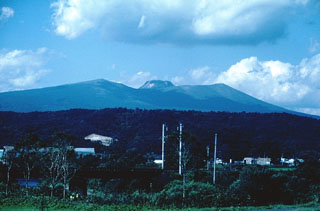 Tarumai volcano, seen here from the SW contains a flat-topped lava dome that formed during an eruption in 1909. The dome was emplaced within a small caldera at the summit that formed during major explosive eruptions in 1667 and 1739 CE.
Tarumai volcano, seen here from the SW contains a flat-topped lava dome that formed during an eruption in 1909. The dome was emplaced within a small caldera at the summit that formed during major explosive eruptions in 1667 and 1739 CE.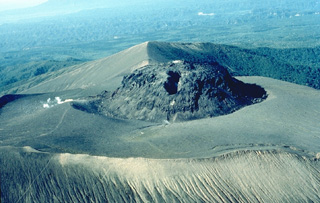 The flat-topped lava dome at the summit of Tarumai volcano was formed during an eruption in 1909. Frequent explosive eruptions took place from January 11 until April. On April 19 the new lava dome appeared. The dome grew to a height of 130 m and a width of 450 m. This 1981 photo views the dome from the NE.
The flat-topped lava dome at the summit of Tarumai volcano was formed during an eruption in 1909. Frequent explosive eruptions took place from January 11 until April. On April 19 the new lava dome appeared. The dome grew to a height of 130 m and a width of 450 m. This 1981 photo views the dome from the NE.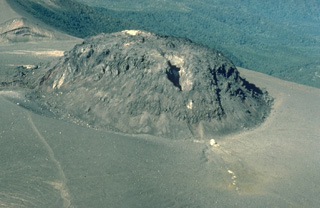 A 130-m-high lava dome was emplaced at the summit of Tarumai volcano on Hokkaido in 1909. The dome grew rapidly near the end of an explosive eruption that began on January 1. An eruption in 1917 produced the fissure that cuts diagonally across the dome. Subsequent eruptions have occurred along this fissure and at other locations on the summit and flanks of the dome.
A 130-m-high lava dome was emplaced at the summit of Tarumai volcano on Hokkaido in 1909. The dome grew rapidly near the end of an explosive eruption that began on January 1. An eruption in 1917 produced the fissure that cuts diagonally across the dome. Subsequent eruptions have occurred along this fissure and at other locations on the summit and flanks of the dome.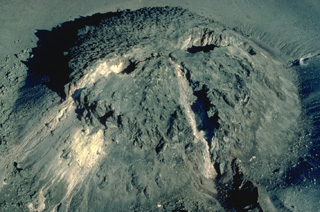 This face-like feature is formed by fissures cutting across a lava dome at the summit of Tarumai volcano on the northern Japanese island of Hokkaido. Two sets of fissures transect the dome, the one trending N30W (lower right) forming the "nose," and the other trending N60E. The lava dome dates to an eruption in 1909. The N60E fissure was formed during an eruption in 1917; later localized eruptions formed the "eyes."
This face-like feature is formed by fissures cutting across a lava dome at the summit of Tarumai volcano on the northern Japanese island of Hokkaido. Two sets of fissures transect the dome, the one trending N30W (lower right) forming the "nose," and the other trending N60E. The lava dome dates to an eruption in 1909. The N60E fissure was formed during an eruption in 1917; later localized eruptions formed the "eyes."  Tarumai volcano was constructed on the SE rim of the 13 x 15 km Shikotsu caldera. The summit has a small 1.5-km-wide caldera that formed during eruptions in 1667 and 1739 CE. It contains a flat-topped summit lava dome that was extruded in 1909. Two other Holocene post-caldera volcanoes occur at Shikotsu, Fuppushi (adjacent to Tarumai) and Eniwa, on the opposite side of the caldera.
Tarumai volcano was constructed on the SE rim of the 13 x 15 km Shikotsu caldera. The summit has a small 1.5-km-wide caldera that formed during eruptions in 1667 and 1739 CE. It contains a flat-topped summit lava dome that was extruded in 1909. Two other Holocene post-caldera volcanoes occur at Shikotsu, Fuppushi (adjacent to Tarumai) and Eniwa, on the opposite side of the caldera.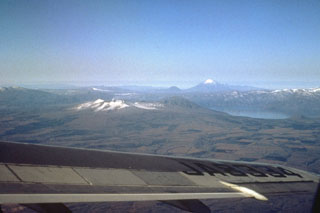 Shikotsu caldera, seen from the SE with Yoteizan volcano on the horizon, is a 13 x 15 km caldera filled by Lake Shikotsu. Following formation of the caldera more than 30,000 years ago, three small cones were constructed along a NW-trend across the caldera. Snow-capped Tarumai (left center) formed near the SE rim of the caldera, along with Fuppushi to its right. A third volcano, Eniwa, was constructed on the NW caldera rim at the far side of the lake.
Shikotsu caldera, seen from the SE with Yoteizan volcano on the horizon, is a 13 x 15 km caldera filled by Lake Shikotsu. Following formation of the caldera more than 30,000 years ago, three small cones were constructed along a NW-trend across the caldera. Snow-capped Tarumai (left center) formed near the SE rim of the caldera, along with Fuppushi to its right. A third volcano, Eniwa, was constructed on the NW caldera rim at the far side of the lake.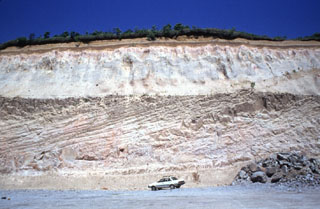 These thick pyroclastic flow deposits were produced during the major eruption that formed the 13 x 15 km Shikotsu caldera. The eruption produced 125 km3 of rhyolite tephra and pyroclastic flows. Pyroclastic flows traveled as far as 40 km, reaching the Pacific coast over a broad area. This outcrop is located 15 km ENE of the caldera.
These thick pyroclastic flow deposits were produced during the major eruption that formed the 13 x 15 km Shikotsu caldera. The eruption produced 125 km3 of rhyolite tephra and pyroclastic flows. Pyroclastic flows traveled as far as 40 km, reaching the Pacific coast over a broad area. This outcrop is located 15 km ENE of the caldera.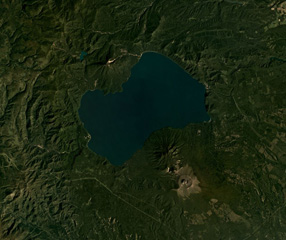 The 14 x 12 km Shikotsu caldera is shown in this September 2019 Planet Labs satellite image monthly mosaic (N is at the top; this image is approximately 28 km across). Tarumae is the cone on the SE rim of the caldera with a roughly 1.5-km-wide crater containing a lava dome. Between Tarumae and the caldera lake is the eroded Fuppushi cone. On the opposite (NW) side of the caldera is the Eniwa cone.
The 14 x 12 km Shikotsu caldera is shown in this September 2019 Planet Labs satellite image monthly mosaic (N is at the top; this image is approximately 28 km across). Tarumae is the cone on the SE rim of the caldera with a roughly 1.5-km-wide crater containing a lava dome. Between Tarumae and the caldera lake is the eroded Fuppushi cone. On the opposite (NW) side of the caldera is the Eniwa cone.The following 3 samples associated with this volcano can be found in the Smithsonian's NMNH Department of Mineral Sciences collections, and may be availble for research (contact the Rock and Ore Collections Manager). Catalog number links will open a window with more information.
| Catalog Number | Sample Description | Lava Source | Collection Date |
|---|---|---|---|
| NMNH 101495 | Volcanic Rock | TARUMAI | -- |
| NMNH 111123-1960 | Unidentified | TARUMAI | -- |
| NMNH 91408 | Volcanic Bomb | TARUMAI | -- |
| Copernicus Browser | The Copernicus Browser replaced the Sentinel Hub Playground browser in 2023, to provide access to Earth observation archives from the Copernicus Data Space Ecosystem, the main distribution platform for data from the EU Copernicus missions. |
| MIROVA | Middle InfraRed Observation of Volcanic Activity (MIROVA) is a near real time volcanic hot-spot detection system based on the analysis of MODIS (Moderate Resolution Imaging Spectroradiometer) data. In particular, MIROVA uses the Middle InfraRed Radiation (MIR), measured over target volcanoes, in order to detect, locate and measure the heat radiation sourced from volcanic activity. |
| MODVOLC Thermal Alerts | Using infrared satellite Moderate Resolution Imaging Spectroradiometer (MODIS) data, scientists at the Hawai'i Institute of Geophysics and Planetology, University of Hawai'i, developed an automated system called MODVOLC to map thermal hot-spots in near real time. For each MODIS image, the algorithm automatically scans each 1 km pixel within it to check for high-temperature hot-spots. When one is found the date, time, location, and intensity are recorded. MODIS looks at every square km of the Earth every 48 hours, once during the day and once during the night, and the presence of two MODIS sensors in space allows at least four hot-spot observations every two days. Each day updated global maps are compiled to display the locations of all hot spots detected in the previous 24 hours. There is a drop-down list with volcano names which allow users to 'zoom-in' and examine the distribution of hot-spots at a variety of spatial scales. |
|
WOVOdat
Single Volcano View Temporal Evolution of Unrest Side by Side Volcanoes |
WOVOdat is a database of volcanic unrest; instrumentally and visually recorded changes in seismicity, ground deformation, gas emission, and other parameters from their normal baselines. It is sponsored by the World Organization of Volcano Observatories (WOVO) and presently hosted at the Earth Observatory of Singapore.
GVMID Data on Volcano Monitoring Infrastructure The Global Volcano Monitoring Infrastructure Database GVMID, is aimed at documenting and improving capabilities of volcano monitoring from the ground and space. GVMID should provide a snapshot and baseline view of the techniques and instrumentation that are in place at various volcanoes, which can be use by volcano observatories as reference to setup new monitoring system or improving networks at a specific volcano. These data will allow identification of what monitoring gaps exist, which can be then targeted by remote sensing infrastructure and future instrument deployments. |
| Volcanic Hazard Maps | The IAVCEI Commission on Volcanic Hazards and Risk has a Volcanic Hazard Maps database designed to serve as a resource for hazard mappers (or other interested parties) to explore how common issues in hazard map development have been addressed at different volcanoes, in different countries, for different hazards, and for different intended audiences. In addition to the comprehensive, searchable Volcanic Hazard Maps Database, this website contains information about diversity of volcanic hazard maps, illustrated using examples from the database. This site is for educational purposes related to volcanic hazard maps. Hazard maps found on this website should not be used for emergency purposes. For the most recent, official hazard map for a particular volcano, please seek out the proper institutional authorities on the matter. |
| IRIS seismic stations/networks | Incorporated Research Institutions for Seismology (IRIS) Data Services map showing the location of seismic stations from all available networks (permanent or temporary) within a radius of 0.18° (about 20 km at mid-latitudes) from the given location of Shikotsu. Users can customize a variety of filters and options in the left panel. Note that if there are no stations are known the map will default to show the entire world with a "No data matched request" error notice. |
| UNAVCO GPS/GNSS stations | Geodetic Data Services map from UNAVCO showing the location of GPS/GNSS stations from all available networks (permanent or temporary) within a radius of 20 km from the given location of Shikotsu. Users can customize the data search based on station or network names, location, and time window. Requires Adobe Flash Player. |
| DECADE Data | The DECADE portal, still in the developmental stage, serves as an example of the proposed interoperability between The Smithsonian Institution's Global Volcanism Program, the Mapping Gas Emissions (MaGa) Database, and the EarthChem Geochemical Portal. The Deep Earth Carbon Degassing (DECADE) initiative seeks to use new and established technologies to determine accurate global fluxes of volcanic CO2 to the atmosphere, but installing CO2 monitoring networks on 20 of the world's 150 most actively degassing volcanoes. The group uses related laboratory-based studies (direct gas sampling and analysis, melt inclusions) to provide new data for direct degassing of deep earth carbon to the atmosphere. |
| Large Eruptions of Shikotsu | Information about large Quaternary eruptions (VEI >= 4) is cataloged in the Large Magnitude Explosive Volcanic Eruptions (LaMEVE) database of the Volcano Global Risk Identification and Analysis Project (VOGRIPA). |
| EarthChem | EarthChem develops and maintains databases, software, and services that support the preservation, discovery, access and analysis of geochemical data, and facilitate their integration with the broad array of other available earth science parameters. EarthChem is operated by a joint team of disciplinary scientists, data scientists, data managers and information technology developers who are part of the NSF-funded data facility Integrated Earth Data Applications (IEDA). IEDA is a collaborative effort of EarthChem and the Marine Geoscience Data System (MGDS). |